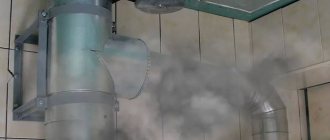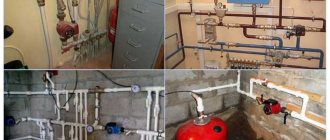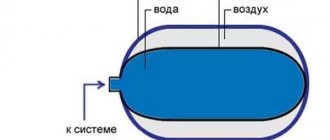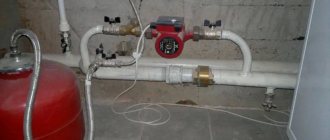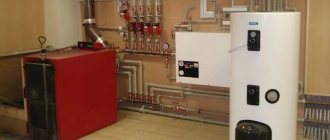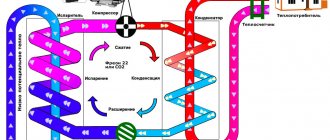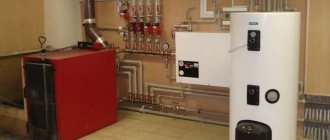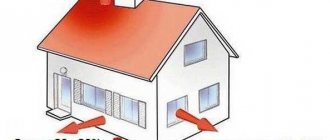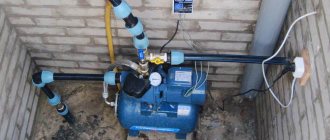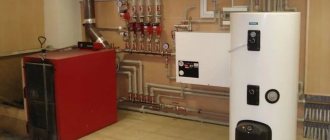It is not often possible to organize the inclusion of a private house, summer house or cottage in the centralized water supply system. Usually their owners have to decide on an autonomous water supply system for their home.
But, even if it is possible to connect to a city or village water supply running next to the house, having an independent source of water on the site is not a bad idea, both from an economic point of view, for example, using it for irrigation, and as a guarantee against sudden central system shutdowns.
general information
The autonomous water supply system of a private house consists of several components:
- water source:
- A well is an artificial excavation-mine dug to collect underground groundwater in the surface aquifer to a depth of 10~15 m and reinforced against collapse.
- Wells . They are carried out by drilling and come in several types: Gravity : “on sand” - up to 50 m, “on limestone” - up to 150 m.
- Artesian - over 150 m.
- Abyssinian and others.
- Water consumers on site and in the house : sinks, sinks, baths, saunas, swimming pools, irrigation.
- Supply and distribution system : pumps, storage tanks, pipelines.
When designing an autonomous system, the first question that arises is the selection of a pump for the water supply of a private home, as one of the most important and, if we talk about the quality of work and durability, the most expensive part of the hydraulic equipment. And its choice is determined, first of all, by the type of water source on the site , and then by the selected water supply scheme.
Design differences
Hydraulic pumps come in the following design types:
Review of manufacturers
There are many models of well pumps on the market from domestic and foreign manufacturers.
- Gilex Water Cannon. The pump is assembled on the territory of the Russian Federation. The model has a unique design. The electric motor is located on top of the housing, and the impellers with blades are located on the bottom. Due to this, the liquid intake is located from below, which is considered not the best option, since silt and sand will rise from the bottom of the source. All parts are made of plastic, which greatly facilitates the design, but does not extend its service life.
- Aquarius BCPE. Ukrainian-German components make the pump strong and durable. The average service life of the device is 10-12 years. The peculiarity of this option is the ability to withstand prolonged blocking of water flow without further breakdowns. Another advantage is the budget price.
- Aquario. Italian pumps of good quality with a wide range of models. You can find options with a built-in capacitor or a remote control unit with circuit protection elements against voltage surges.
Gilex Vodomet
Aquarius BCPE
Aquario
If it is not possible to purchase a high-quality device, you can take a Chinese model.
Types by type of accommodation
According to the method of placement, water supply hydraulic pumps are divided into two classes:
- Surface type . Located away from the water source, they ensure its suction through a pipe lowered into a well or borehole.
- Submersible . They sink completely into the water to a certain depth.
pumping stations are classified into a separate class , which are essentially a compact, self-sufficient water-pressure complex consisting of a surface pump, a membrane accumulator tank, a water pressure switch and a control circuit.
Which one is better to choose?
Before choosing a water pump for your home, you should compare the advantages and disadvantages of their two main types:
| Surface pumps | Submersible |
| Installed permanently. Easier to maintain. | For repair and maintenance work, they require lifting from a well or well to the surface. |
| They need two pipelines: suction and discharge. | They work only for injection. |
| The maximum suction height is 10 m. The real one, taking into account losses in the pipeline and the reserve for lowering the water level in the well, is no more than 7~8 m. | Ascent from depths below 10 m. |
| They need to be filled with liquid before the first start-up or after repair work. | Ready to go immediately after diving. |
| There is a danger of the motor overheating during prolonged operation. | A pump immersed in water is cooled both by external water from the outside and pumped from the inside. |
| The need for winter preservation for the summer version of the water supply system. | For the winter, it is enough to drain the water from the system. |
| Work is accompanied by noise. | Silent. |
Calculation example
Basic necessary data for choosing the appropriate surface pump model for water supply at home:
- Maximum fluid flow rate in l/min or m³/h.
- Suction height is the difference between the levels of the pump inlet pipe and the surface of the water in the source.
- Discharge height is the difference in levels between the highest point of the pipeline and the pump outlet pipe.
- The initial pressure for a free-flow well or well is equal to atmospheric pressure.
- Final - the required pressure in the home plumbing system.
- Pressure losses in pipelines depend on the fluid flow and the quality of the surfaces of the internal walls of the pipelines, which create friction for its movement.
The suction height of surface-type hydraulic pumps cannot exceed 10.33 m - the height of the water column creating equal atmospheric pressure.
To simplify calculations , it is rounded to 10 m , and the pressure created is equated to one technical atmosphere, 1 at = 1 kG/cm², or approximately 1 bar ~ 0.98 at.
The discharge height, or pressure, is determined by the technical parameters and power of the unit .
Often the value of pressure is confused with pressure, calling one another. These quantities are equivalent, but not exactly equal to each other. The pressure at the outlet of the pump depends only on its technical characteristics, and the pressure depends on the totality of external conditions : flow rate and liquid consumption, its temperature, altitude above sea level, etc.
When calculating, all system pressure values in pascals, bars, atmospheres and other units lead to equivalent pressure values in meters .
Let's give an example, taking the geodetic level of the pumping station location as zero:
- The fluid flow provided by the hydraulic pump is 40 m³/h. This is quite sufficient consumption for household needs.
- The water level in the well is 4 m below zero.
- The highest point of water rise is 15 m above it.
- The total losses in the inlet and outlet pipelines can be found in the tables for a specific type of pipe, but they are usually calculated based on the fact that for every 10 m of the pipeline 1 m of pressure is lost, therefore we will take them equal to (15 m + 4 m) / 10 = 1 .9 m.
- Let us take the final pressure at the top point to be 1 bar ~ 9.87 m.
If the water pumping station is installed not in a caisson located next to the well, but in a house, you should also take into account the pressure loss along the length of the supply pipeline .
For each pump there is an operational characteristic that shows the pressure drop depending on the flow rate and has something like this :
When choosing a specific pump model, you should compare the calculated parameter values with the nameplate values for the selected unit at the required operating point.
For our example we get : 2.725 x 40 x 30.77 = 3.354 kW.
For more information on calculating and selecting a pump for water supply to a country house, watch this video:
Selecting a pump for domestic hot water
Hot water recirculation pump
The selection and calculation of pumps for hot water supply is not much different from the selection of units for cold water supply. But you need to take into account some features.
- When calculating the amount of water per person, we take the norm to be 140-150 liters per day.
- To calculate peak flow rates for plumbing fixtures, you can use the same table from SNiP 2.04.01-85, which is given above - in addition to the cold water flow rate, it also shows the hot water flow rate, which is naturally less.
- When choosing a pump pressure, you need to focus on the pressure in the cold water supply. These numbers must be equal, otherwise, with faulty mixers, hot water can be squeezed into cold water and vice versa; the network in which the pressure is higher will displace liquid from the pipelines where it is lower.
- The depth of lift (suction) is not important to us. Water is supplied to the pump inlet under pressure.
- Not all pumps can operate at elevated temperatures. You need to choose only models designed for hot water supply networks.
Inclusion in the water supply system
As mentioned above, ready-made pumping stations are more convenient to install and operate than others , the technical characteristics of which are suitable for supplying water to a small house for a family of 2~3 people or a summer house.
Connecting them comes down to a few simple steps:
- Choosing a location.
- Preparing a solid foundation.
- Laying out the necessary pipelines.
- The suction pipe lowered into the well must be equipped with a strainer and a check valve. It should be lowered to a depth no higher than 1 m from the surface of the water.
- Connecting the electrical network and protective grounding.
Throttle control at constant speed.
Let's assume that the pump is connected as shown in the diagram.
Let us plot on the graph the characteristics of pressure, power and efficiency of a centrifugal pump at a constant speed.
On the same graph we depict the characteristics of the pipeline network on which the pump operates. In this case, it is assumed that the control throttle is fully open.
Steady-state operation of a centrifugal unit is possible only if the pump pressure is equal to the pressure consumed in the system. This equality is observed at point a.
If the throttle on the pressure pipe is closed, point a will move along the characteristic to the left and take position a / , setting new values for the parameters Q / , H / , N / .
Consequently, throttle control at a constant speed is achieved by introducing additional hydraulic resistance into the machine's pipeline network.
Since the highest flow is achieved when the throttle is fully open (point a), throttle control is used only to reduce the flow. The energy efficiency of such regulation is low, but due to its simplicity this method is widely used.
When throttling control of centrifugal machines that supply liquid, the throttle is placed on the pressure pipe. If it is placed on the suction pipe, cavitation may occur during deep regulation.
Changing the shaft speed
In cases where it is possible to change the rotation speed of the motor shaft driving the centrifugal machine, it is advisable to use this option.
The pump is connected to the pipeline in the same way as in the previous diagram and operates at rotation speeds n1, n2, n3, with n1
Source
Weaknesses of pumping stations and major breakdowns
Industrially produced pumping stations, or so-called self-priming pumps, attract:
- affordable price , less than when purchasing all components separately;
- compact sizes;
- ease of installation and maintenance;
- ready for use immediately after purchase.
However, there are also disadvantages to using them:
- Suction height limited to 7~8 meters. It can be increased by a couple of meters by placing the unit in a recessed caisson next to the well.
- The need to equip a special insulated, soundproofed room.
- Small hydraulic accumulator capacity 20~50 l.
- Noise during operation.
Malfunctions of pumping stations can be caused by the following reasons:
- A sudden power outage is often accompanied by water hammer, which can cause irreparable damage.
- Contamination and poor water quality lead to increased wear of the centrifugal hydraulic pump blades and silting of the tank.
- Inconsistency of operating conditions with technical parameters.
For example, one of the common breakdowns is associated with excessive water consumption, when the frequency of switching on/off the station significantly exceeds the rated one .
This leads to rupture of the membrane in the accumulator tank. In this case, the station cannot create the required pressure in the system and the frequency of switching on increases even more. Check by pressing the nipple on the back of the tank : if water flows from there, the membrane requires replacement.
Another common malfunction is a breakdown or incorrect adjustment of the pressure switch , which leads to continuous operation of the station without shutdowns.
Residents of city houses or apartments rarely think about the fact that when they go to the faucet in the kitchen or bathroom and simply open it, they include in the work perfected for its creation by centuries of scientific discoveries, inventions and engineering solutions, a huge and complex system of water resources extraction , their delivery and distribution.
Those who have to create such a miniature system for their home truly value the value of this truly irreplaceable source of life - water.
What do you think of this article?
Useful tips
When choosing a pump for a heating system, preference should be given to designs with a “wet” rotor, since they operate very quietly and withstand higher loads than hydraulic devices of other modifications.
In addition, pay attention to the material of the case - opt for products made of stainless steel, bronze or brass. Preference should also be given to models with bearings and shafts made of ceramics. The service life of such equipment exceeds 20 years.
When installing the device into the system, it is necessary to ensure that the impeller shaft is positioned horizontally, that is, parallel to the pipe. If a suspicious noise appears during operation of the pump, this does not indicate a malfunction or a manufacturing defect. Try bleeding the air remaining in the system after starting.
